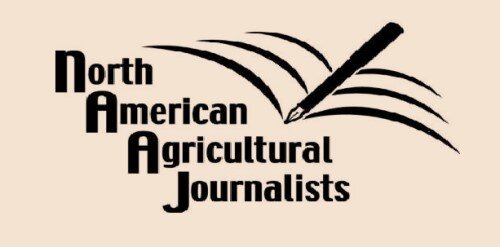NAAJ Special Projects Winners - 2022
Unlike all other categories, entries in this category may include work from writers who are not NAAJ members. A special project entry takes reporting to a higher level. The overall entry shows careful planning and enterprise. The entry also shows that time, talent, and in some cases, monetary commitments were made to produce the project. May be a team effort.
Number of entries: 10
Comments about the competition: These were outstanding entries! I read every word -- quite the assignment. They were fascinating.
Judge: Nancy Edmonds Hanson — Freelance writer, journalism teacher at Minnesota State University, former reporter, The Forum (Fargo, N.D.)
FIRST PLACE — DTN/Progressive Farmer
Gregg Hillyer, Pamela Smith, Matthew Wilde, Des Keller, Emily Unglesbee
Gene Revolution Turns 25 — February 2021
Judge’s comments: This series does a first-rate job of explaining the highly technical nature of genetic research while tying it directly to everyday concerns of producers. The writers did and exemplary job of interviewing experts (whose knowledge I assume they did not share) and translating it directly to address producers' concerns in clear, compelling text. My favorite topic of this series was the one addressing Europe's fixation on non-GMO products. Bravo!
Gene-Altered Attitudes: Will consumers accept the next round of plant miracles?
Designer Crops: CRISPR’s genetic scissors slice through crop problems to improve varieties
Press the Edit Button: New tools hasten future seed and trait introductions
Shot Heard Around the World: Gene gun helped to ignite agriculture’s biotechnology revolution
Genetic Snapshots in Time [graphic]
Brave New Plant World: These GM crops may be the technology’s best chance to win over the public.
SECOND PLACE — Iowa Farmer Today
Jeff DeYoung, Aaron Viner, Benjamin Herrold, Phyllis Coulter, Nat Williams, Gene Lucht
Labor Crunch — 7/31/2021
Judge’s comments: When so many of us think of the labor crunch, we unconsciously assume it's a problem in urban America. Those in ag, of course, know otherwise ... but still may underestimate how it's affecting every aspect of their industry. From farm labor to manufacturing to alternatives that are being pursued to find solutions -- like South African contract workers -- the team put together strong information on a thoughtful range of topics
Labor Crunch — 7/31/2021
— Farms, rural communities struggle to meet labor needs
— With demand high, machinery companies face labor challenge
— Tech helps some farmers tackle labor shortages
— Small towns scramble during labor shortage
— Immigration bills focused on ag labor have chance to pass
— Farmers reach across the ocean for workers
— Economists see typical end to high price cycle (and jump from lead story above)
THIRD PLACE — Harvest Public Media & Investigate Midwest
Dana Cronin, Katie Peikes and Seth Bodine, Harvest Public Media
and Johnathan Hettinger and Sky Chadde, Investigate Midwest
Corporate money keeps university ag schools ‘relevant,’ and makes them targets of donor criticism — 11/15/2021
A giant investment firm paid a university to study one of its biggest assets: farmland — 11/16/2021
As tax dollars dry up, university ag schools turn to agribusiness dollars and industry projects – 11/16/2021
Judge’s comments: I like that the writer states a position in the first graph. Too often writers load up the beginning of editorials with background and asides that leave the reader wondering what it is about and why they are reading it. The writer uses the example of a popular TV series and other works of fiction to note the tendency to glamourize rustling. The writer takes a position, arguing rustling is theft and it should not be portrayed as a lesser crime. The piece notes examples of recent cattle thefts in the region. The argument would have been more convincing if details of these thefts were provided: What was the value of the cattle? Was the management of the herd disrupted long term? How were the cattle distressed by the rustling? Show the harm. The piece ends by saying efforts to curtail rustling would be assisted by closing down the myth of the rustler as anti-hero. The editorial would have been stronger if it had suggestions about how to end that myth. Do the courts take the crime seriously enough? Do media organizations cover cattle rustling as major thefts? Should cattle organizations write to TV producers outlining concerns about portrayals of cattle rustling?
HONORABLE MENTION — Politico
Helena Bottemiller Evich, Liz Crampton, Annette Choi, Joanne Kenen, Ryan McCrimmon, Ximena Bustillo
Judge’s comments: The Recovery Lab series has added new dimension to the reflection on how Covid-19 has thrown our food production and food chain into sharp, often unflattering relief. I enjoyed this exercise in considering the future and how both America's producers and the health of its people may be affected in the long term by the cascade of dilemmas and work-arounds the pandemic has brought to the fore.
Could Covid-19 finally end hunger in America? 9/9/2021
Policy Hackathon: How to crisis-proof our food supply 9/9/2021
What Covid-19 taught America about food and hunger, in 5 charts 9/9/2021
Prescribing tomatoes and carrots could help some Americans eat better 9/16/2021
America’s meat supply is cheap and efficient. Covid-19 showed why that’s a problem. 9/23/2021

